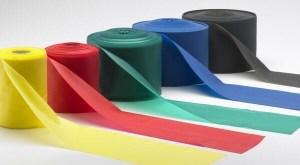Finding a user-friendly exercise program for patients diagnosed with related ataxia symptoms isn’t easy. Gary, for example, is limited to lifting 10lbs, so he doesn’t cause fresh bleeding into his CNS. Standing or sitting with free weights is a no-no; even without the lifting limit, you wouldn’t want to be the spotter with his balance problem. Before his nerve block, getting down on the floor to do planks, sit-ups or leg lifts would bring an instant migraine.
Exercising was a minefield.
Gary’s appointment for his balance and gait evaluation gave us the opportunity to ask the kinesiology department these questions. He needed a low-impact strength program designed so it:
- Could be done at home
- Wouldn’t trigger headaches
- Balance problems wouldn’t interfere
- Muscle tone could be strengthened or maintained

“A recent study demonstrated that elastic resistance training is as effective as isotonic weight machines for increasing strength and muscle mass” (Colado & Triplett, 2008)
The physical therapist built a program with ten strength exercises, each set targeting the upper or lower body using resistance bands.
If you’ve never used a resistance band during exercise, I think you will be surprised with their efficiency. The therapist first demonstrated each activity and then had Gary repeat it. Most are done sitting on a chair. A few of the more advanced exercises require holding on to a table for balance while standing.
The color of the band is coded to correspond to the level of tension. You can increase the tension (pounds of resistance) by shortening the resistance band, so you don’t need to own every color.

Theraband latex-free is the brand used by Gary’s kinesiology department, so we’re using their information for this post. The company has an excellent reputation, but you can choose a brand available to you. It’s essential to read and understand all the safety precautions before using a resistance band.
- Be aware of some exercises may cause the band to snap back towards your head. Protect your eyes.
- Examine your band, every time, for damage before using and discard if there is a chance it may break.
- Make sure your band is the correct length.
- Don’t overstretch your band.
- Store them out of direct sunlight or heat.
- If you use them in a chlorinated pool rinse them well after with clear water.
- If they are sticky or slippery, wash them with soapy water, rinse, lie flat to dry and dust with cornstarch before storing.
Once again, don’t let the simplicity of the bands fool you. Gary thought this program would be easy. Right now he is using the red band for the upper body exercises and the black one for lower body. The first time Gary tried to power through the whole program. He didn’t make it. The next day, hello pain. Over time, we feel he will build up to more extended sessions.
He spent the next day soaking in Epsom salts and having an arnica massage. Lesson learned, start out slowly, the bands aren’t toys. Gary now works out to a split schedule. Five lower body exercises day one, Five upper body day two, rest day three. He continues with the next five lower body exercises day four and then finishes with the last five upper body exercises. Rest day.
The link below will take you to the description and instructions page. We’ve uploaded the set in .pdf form so you can download or print a copy.
We’re hoping to add new activities as time goes on.
What kind of program do you follow?
The Exercise Program Set
Upper Body
- Shoulder Press
- Front Shoulder Raise
- Lateral Shoulder Raise
- Shoulder Rear Delt Fly
- Upright Row
- Bent Over Row
- Low Row
- Chest press
- Bicep Curl
- Tricep Press
Lower Body
*Hard with balance issues *** Challenging with balance issues
- Leg Press
- Hip Adduction*
- Hip Abduction*
- Standing SLR*
- Knee Flexion
- Knee Extension
- Ankle Pumps
- Ankle Eversion
- Ankle Inversion
- Mini Squat***

